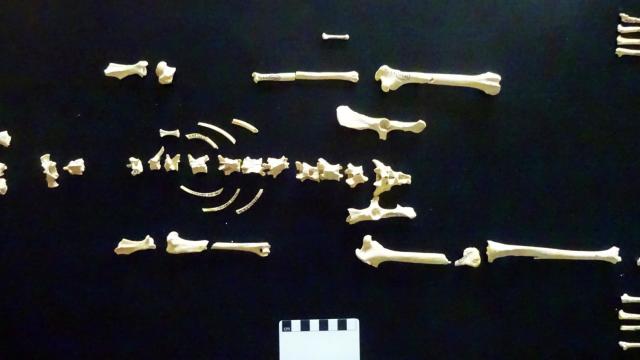Archaeologists in Britain have uncovered evidence of chickens and brown hares being buried fully intact and with great care in the centuries leading up to the Roman period. It’s further evidence that these animals, which would eventually become important food staples, were once associated with gods.
When the first chickens and brown hares arrived in Britain some 2,300 to 2,200 years ago, they weren’t brought in as food but were instead treated as spiritual objects, according to research led by Naomi Sykes from the University of Exeter. This research project, which also involves scientists from the Universities of Leicester and Oxford, is an investigation into how animals, including chickens and rabbits, have come to be associated with Easter festivities.
Initially, “they weren’t released into the wild or farmed, not for several hundred years,” Sykes told Gizmodo, adding that chickens and brown hares were introduced as “special exotica.” It would only be later, during the ensuing Roman period, that their novelty wore off and they were instead seen as tasty meals to be served at dinner.
Newly acquired radiocarbon dates of buried specimens show that brown hares and chickens were initially brought to Britain during its Iron Age, between the 5th and 3rd centuries BCE. Later, during the Roman period (43 CE to 410 CE), rabbits were introduced to Britain and both chickens and brown rabbits were farmed and eaten, said Sykes.
Analysis of multiple specimens found in Iron Age hillforts and large settlement centres showed that Britons buried their chickens and brown hares with care.
“We believe they were buried with care because, in the Iron Age, we find complete skeletons—this is unusual unless animals have been carefully buried,” Sykes told Gizmodo. “Normally we find disarticulated bones.”
It’s a nice case in which the archaeological evidence jibes with historical records.
In his account of the Gallic Wars, Roman Emperor Julius Caesar made a note of this behaviour, writing that the “Britons consider it contrary to divine law to eat the hare, the chicken, or the goose. They raise these, however, for their own amusement and pleasure.” Years later, Roman historian Dio Cassius described the actions of Queen Boudica, who led an uprising against the Roman invaders in 60/61 CE. Appealing to Andraste, the warrior goddess of Celtic Britain, Boudica released a live hare in hopes of procuring a divinely ordained victory.
In a University of Exeter press release, Sykes described the early British people’s fascination with these now-mundane animals:
The idea that chickens and hares initially had religious associations is not surprising as cross-cultural studies have shown that exotic things and animals are often given supernatural status. Historical accounts have suggested chickens and hares were too special to be eaten and were instead associated with deities—chickens with an Iron Age god akin to Roman Mercury, and hares with an unknown female hare goddess. The religious association of hares and chickens endured throughout the Roman period.
Eventually, however, and as the Roman period progressed, the Britons began to feast on these animals. As Sykes explained to Gizmodo, a lot of it had to do with the large size of the livestock population.
“When a species is rare, it’s seen as special, but as numbers grow, they become more commonplace and mundane, like that saying, ‘familiarity breeds contempt,’” she said.
But these new eating habits were disrupted when the Romans pulled out of Britain in 410 CE—a move that caused substantial economic turmoil. The populations of chickens and brown hares plummeted, while rabbits disappeared completely, according to the researchers.
Once again, it became taboo to eat these animals, but things changed owing to Saint Benedict, who in the 6th century made it illegal to consume four-legged animals during fasting periods, including Lent. Over time, this practice would make the consumption of chickens and their eggs commonplace by the medieval era. As for rabbits, they came back into vogue during the 13th century, but their association with Easter didn’t happen until the 19th century and the Victorian period.
This research is neat because it provides insights into the minds of ancient Britons, who had a seemingly reasonable response to the introduction of novel creatures. Choosing to not eat an unfamiliar organism seems like a perfectly sensible approach.
Sykes and her colleagues will be publishing this research to a peer-reviewed journal in the coming months.
